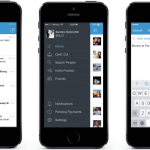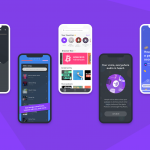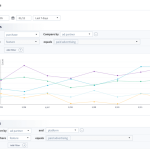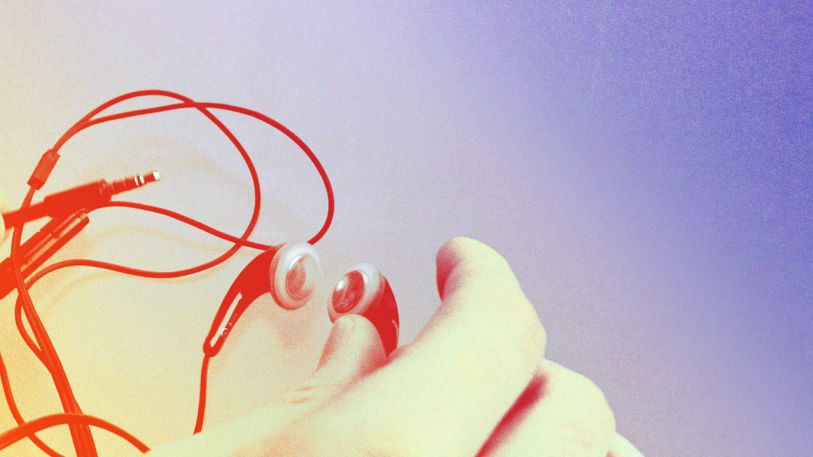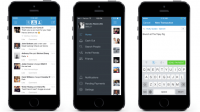Pandora Just Released Its Spotify Killer, And It’s Surprisingly Impressive
In a way, opening the new Pandora app feels like running into an old friend. For one thing, I haven’t been using Pandora much for the last few years, opting instead to binge on music via Spotify, SoundCloud, and vinyl, dipping into Pandora only rarely. But just like someone from an earlier phase of life, Pandora seems to know me and we pick up right where we apparently left off: listening to Slowdive, the dreamy English shoegaze band from the 1990s. I didn’t ask Pandora to take me down this road, but it suits my mood just fine on this chilly March afternoon.
Of course, Pandora has always been able to dive into a personalized radio station like this. But now the app has a new trick: Its brand-new on-demand music subscription tier, built to rival Spotify and Apple Music, is layered seamlessly on top of its famous people-and-data-powered playlisting engine. Pandora Premium is here. So far it sounds pretty good, but I can’t help but wonder whether or not it’s too late.
Tim Westergren, the Pandora cofounder who became the company’s CEO last year, insists that there’s still time: “One of the reasons we’re doing this is because we think people haven’t done this right yet. Right now, subscription services are 30 million songs and a search box. It’s the equivalent of handing somebody the keys to the record store and saying, ‘Good luck!’”
Indeed, the new Pandora puts curation and discovery first in its design, pushing listeners toward playlists and stations and making it effortlessly easy to create their own. It also goes to great lengths to solve what Westergren terms “the cold start problem” of music services by jumping right into a song when you open the app rather than waiting for the listener to make a decision.
Scrolling through the app, there’s another thread to my digital nostalgia. The app’s design recalls the sleek, minimal interface of Rdio, the on-demand music service I used briefly before Spotify landed in the United States in 2011. It’s no coincidence: Pandora acquired Rdio and its team in late 2015 to build out its foray into the music subscription market now firmly dominated by Spotify. That move, along with its acquisitions of TicketFly and NextBigSound, was made to reposition Pandora in the streaming space, wooing both artists and listeners, and reengineering its business model.
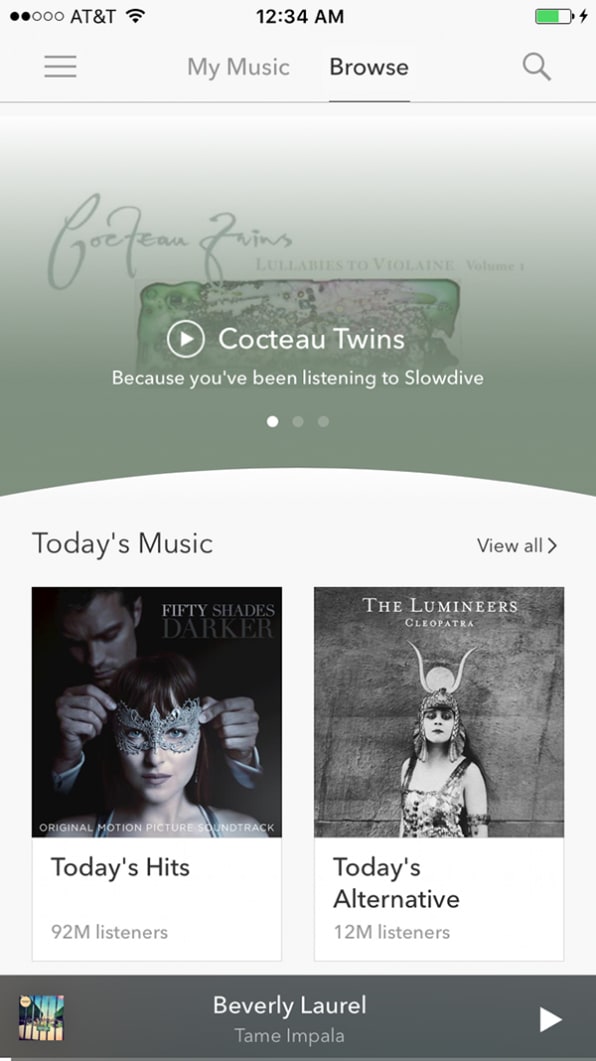
It’s not just design and talent that Pandora absorbed when it bought Rdio. As my Slowdive radio station flows onward, hitting just the right spot with bands like the Jesus and Mary Chain, My Bloody Valentine, and Interpol, it goes somewhere I wasn’t expecting–a song by the Stone Roses that I’m familiar with but hadn’t saved to my virtual music collection on Spotify or anywhere else. For the first time since Pandora launched its music streaming service 12 years ago, I can save the song and even explore the album it’s on. Until now, I would have had to jump over to Spotify or another music app to do that. This moment—when people like me close the app—is the one that Westergren has long hated. Starting this week, he’s hoping we’ll stop.
This, in a nutshell, is why Pandora is shifting courses. As hugely innovative as its internet radio model and the underlying algorithms were when they debuted, music listening has since changed irrevocably. Now we expect instant access to almost any song we can think of—and more than 100 million of us now pay for that luxury. Streaming is now where a majority of the music industry’s revenue comes from and—while the economics of it all are still shaking out for many artists—virtually everyone agrees that these trends will continue well into the future.
The Features: What’s In Pandora’s Shiny New Box?
So what is Pandora Premium? In a sentence, it’s a souped-up version of Rdio woven very seamlessly into the Pandora that its 78 million active listeners already know and love. Like its on-demand competitors, the new Pandora offers access to tens of millions of songs for $10 per month. The company’s executives have talked about the possibility of launching additional tiers and charging more for additional features for super-fans, but this is where they’re starting.
The music selection is more or less what you’d expect from a subscription service, with some noticeable omissions. Few will be surprised to learn that Taylor Swift’s most recent album 1989 is not available, but the rest of her catalog is. At the time of publication, the Beatles’ catalog is not available either. That’s not a shock considering the band only landed on other subscription services 15 months ago, after years of holding out. But details like this are a small competitive setback at a time when the competition is already so fierce.
When music is missing, Pandora is able to offer listeners a small compromise that other services can’t: Because its original internet radio service is based on a compulsory licensing model (rather than the direct deals with labels that on-demand music requires), you can still start a radio station based on those songs and, in theory, hear them in that context. You just can’t pick and choose which of those missing songs you hear or when. So even when an album is missing, Pandora will still show a grayed-out listing in search results hoping that listeners will opt to start a station or keep exploring rather than tap out of the app. And presumably, Pandora must hope, future negotiations with rights holders will fill in many of these blanks.
The main entryway into the listening experience on Pandora is the “My Music” tab. It’s here that Pandora blends your recently played stations and playlists with the music you’ve saved for on-demand playback. Like the company itself, Pandora’s new design is curation-first, giving slightly preferential treatment to playlists and discovery over pick-and-choose, album-oriented listening. But both modes—“lean back” and “lean forward,” in tech industry parlance—are easily accessible from this screen. The “Browse” subsection is where you’ll find personalized, daily-updated new releases and recommended artists, as well as a selection of playlists curated by things like genre, decade, and activity.
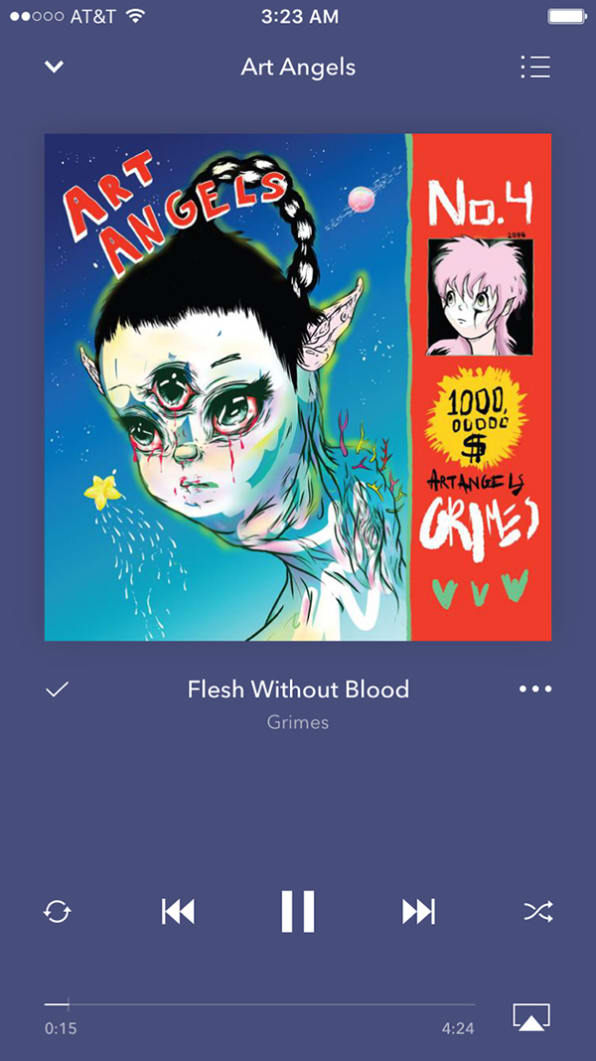
Pandora may be a straggler in the music subscription space, but it’s dragging some distinct advantages over the app launch finish line. Foremost among them is data. After 12 years, over 250 million accounts opened (many listeners have obviously come and gone), and 75 billion thumb button taps, Pandora has amassed a mountain of intelligence about people’s music preferences. This is the company’s bread and butter. Having trained the Music Genome Project with flesh-and-blood musicologists for 17 years (this initiative predates even its radio service), the company has scaled up its music discovery and curation chops with a sophisticated blend of data science, machine learning, and, yes, human music experts.
Not surprisingly, Pandora flexes its legacy muscles throughout its new service. The act of thumbing songs up or down is still prevalent, but now hitting the “thumbs up” button also saves each song to a playlist for later indulging. Bonus: If you’re a longtime Pandora user (even if you’ve abandoned it in recent years), you can go back and listen to the songs you thumbed years ago. This can resurface old gems you’d forgotten about—or perhaps remind you that taste is a nuanced, ever-evolving thing that sometimes refines as we get older. It’s fine.
If you are returning to Pandora after some time away, you may be pleasantly surprised to find original programming like its Questlove Supreme radio show and new features like personalized concert ticket recommendations and seamless ticket buying (for select shows) through its integration with TicketFly.
As one might expect, Pandora injects its data science and personalization prowess into other places inside the app as well. When you’re building a playlist, for instance, a button at the bottom of the screen invites you to let Pandora’s algorithms suggest songs to add, effectively mining the wisdom of the crowd to help ensure you don’t add to the millions of orphaned playlists already floating in the ether. More than anything, this little trick aims to keep you listening longer, as Pandora’s designers try to ward off distractions and keep the app’s engagement metrics palatable to shareholders. From the music that auto-plays when you first launch it to personalized details like this, Pandora Premium seems designed to be as sticky and easy to use as possible.
“Sometimes you want to listen to Dark Side of the Moon from beginning to end,” says Westergren. “Most of the time, that’s not what you want to do. The much harder thing is, when you’re tired of those things, how do you create ongoing engagement? We’re masters of engagement.”
Who Is Pandora Premium For?
The idea of launching a new music subscription service in 2017 would be utterly insane if it weren’t for one detail: Pandora already has 78 million monthly active listeners. If the company has a shot at competing, it will come primarily from its ability to upsell some of these listeners to its new $10 subscription tier.
The rollout of Pandora Premium will be iterative and targeted. It begins this week and will continue through mid-April in phases, selectively coaxing existing Pandora users that might be likely to sign up based on their listening activity. People who hit the song-skipping limit or frequently thumb-up songs by the same artist, for instance, are prime targets for the new service.
One group of listeners that won’t be impressed is the audiophile set. The ‘standard’ quality setting to which Pandora defaults feels like its the equivalent to an 192kbps MP3, which is fine. The ‘high’ quality option sounds better (Don’t bother switching to ‘low’ unless you’re feeling nostalgic for the days of finding cruddy MP3s deep inside the virtual junk drawers of Napster). But listening side by side on a few tracks, Pandora sounds a hair lower in quality than what I’m used to Spotify with the default quality cranked to ‘extreme’ and the in-app EQ settings (a feature that’s notably absent from Pandora, for now) set to my liking. I’m not a religious fanatic when it comes to audio quality, but other services seem to take this detail more seriously. Deezer and Tidal specialize in high-fidelity audio and Spotify is reportedly experimenting with a new hi-fi tier as well. Pandora isn’t there yet. That said, the sound quality of Pandora will do just fine for the average listener, which is who the company is likely aiming for first anyway.
Overall, Pandora is peddling a very polished, well-designed product, but it’s unlikely to reel in many people who are already committed to a service like Spotify or Apple Music. That’s because there’s very little here, aside from aesthetics and a legacy of smart music curation, that can’t be found on other services. Even perks like personalized new releases and the “add similar songs” button found their way into Spotify in the time that’s passed since Pandora acquired Rdio. Unfortunately for Pandora, Spotify has vastly improved its own curation and discovery features over the last year and a half. Pandora is still arguably better at the artist-based radio stations, but Spotify has made itself much more addictive through personalized music features like Discover Weekly, Release Radar, and My Daily Mix, as well as hand-curated playlists. Features like this have helped propel Spotify past the 50 million subscriber mark. Apple Music, also famously heavy on good music curation, is catching up fast with 20 million subscribers. Pandora Premium is solid, but if you’re already invested in another service, you’re likely to find enough here to justify abandoning your music collection and playlists to start fresh.
Of course, that may change. This is only version one of Pandora Premium. Features like more original programming and smarter targeting of super-fans could make Pandora more alluring. It’s also worth noting how much Pandora—and its future product development efforts—stand to gain from all the extra data they’re getting by going into on-demand streaming. Pandora’s music recommendation brain is remarkably smart considering it only learns from signals like the thumbs-up button, which songs and artists you use to start radio stations, and which tracks you skip. Starting this week, Pandora’s algorithms will start learning about people’s music preferences in much more detail and they can only get smarter as a result. Pandora’s product team likely already realizes this, but a playlist import tool would go a long way toward roping people in from other music apps.
It’s also early in the music subscription game. For people who haven’t yet taken the plunge by paying for Spotify or another service, Pandora is a pretty compelling option. Pandora undoubtedly would have been better off had it entered the on-demand music market two or three years ago. Now that it’s here, we’ll see if brand seniority, good design, and smart curation are enough to keep bigger competitors at bay.
When it first launched its internet radio service in 2005, Pandora had very little competition to speak of. The landscape is quite different today as Pandora extends its service into the crowded on-demand music market. Considering how fierce the competition is, Pandora has to be pretty ballsy to not only jump into the game this late, but to base its experience so heavily on its own curation—assuming, for instance, that I’m ready to listen to Slowdive as soon as I open the app.
“People are unforgiving when it comes to music,” says Westergren, seemingly aware of how audacious this curation-heavy foray into a crowded marketplace truly is. “You don’t wait. You pass judgement. You switch stations.”
Fast Company , Read Full Story
(58)


